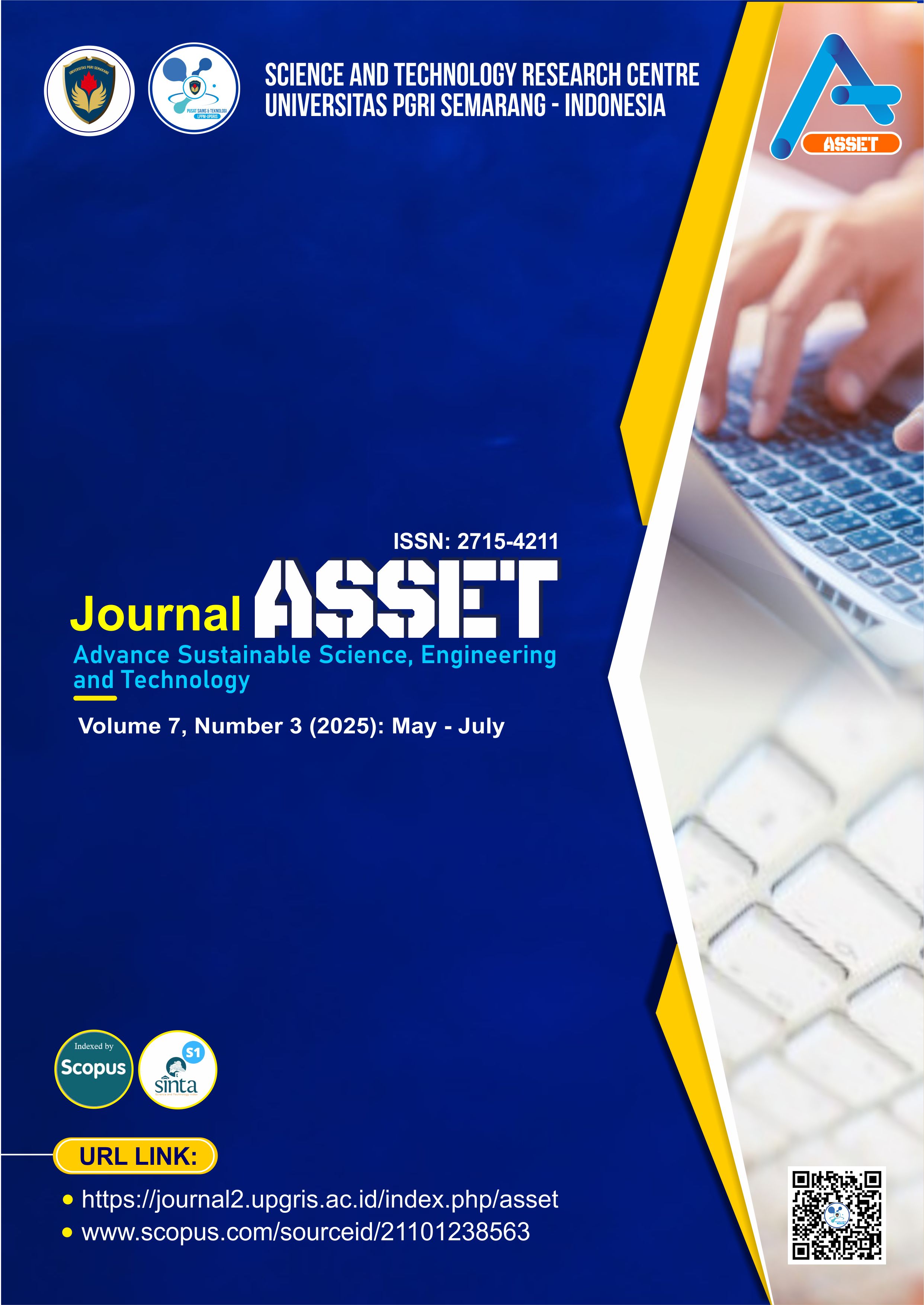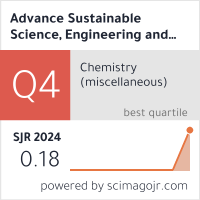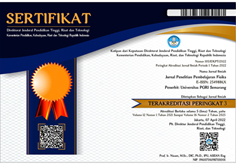Integrating Occupational Safety and Health Management Systems (SMK3) with Total Quality Management (TQM) in Micro-Scale Manufacturing Enterprises
DOI:
https://doi.org/10.26877/asset.v7i4.2054Keywords:
Total Quality Management (TQM), Occupational Safety and Health, SMK3Implementation, Small-Scale Manufacturing, Risk Prevention, Craft Industry, SMEs, TQM-SMK3 IntegrationAbstract
Improving a company's Occupational Safety and Health Management System (SMK3) is key to achieving Total Quality Management (TQM) goals. This study uses questionnaires, fishbone diagrams, and Fault Tree Analysis to evaluate SMK3 implementation at a micro-scale manufacturing business, Malang Roster. The primary goal is to ensure work quality while maintaining a sustainable safety system. Findings show the most significant issues are low discipline in using personal protective equipment (PPE), poor supervision, and outdated equipment. Other challenges include inadequate health insurance planning and the use of subpar equipment. While safety signs are present, unauthorized access to hazardous areas remains a problem, requiring corrective action. To effectively integrate SMK3 into a TQM framework, companies must strengthen provisions, implementation, and monitoring. This study suggests that consistent supervision, targeted training, and structured audits are crucial for improving occupational safety in small manufacturing environments.
References
[1] Sahoo S, Yadav S. Influences of TPM and TQM Practices on Performance of Engineering Product and Component Manufacturers. Procedia Manufacturing 2020;43:728–35. https://doi.org/10.1016/j.promfg.2020.02.111.
[2] Riaz H, Iqbal Ahmad Khan K, Ullah F, Bilal Tahir M, Alqurashi M, Alsulami BT. Key factors for implementation of total quality management in construction Sector: A system dynamics approach. Ain Shams Engineering Journal 2023;14:101903. https://doi.org/10.1016/j.asej.2022.101903.
[3] Babalola A, Manu P, Cheung C, Yunusa-Kaltungo A, Bartolo P. A systematic review of the application of immersive technologies for safety and health management in the construction sector. Journal of Safety Research 2023;85:66–85. https://doi.org/10.1016/j.jsr.2023.01.007.
[4] Sri Purwati, Nancy Oktyajati, Ica Salsa Bila. Evaluating Sustainable Waste Collection Models Using the Analytical Hierarchy Process (AHP): A Multi-Criteria Decision-Making Approach. Advance Sustainable Science Engineering and Technology 2025;7:0250305. https://doi.org/10.26877/asset.v7i3.1471.
[5] Susanto D, Alifa RP, Aylien S, Alkadri MF. Advancing building façade design: digital fabrication of an optimized non-conventional roster brick prototype. Journal of Asian Architecture and Building Engineering 2025:1–25. https://doi.org/10.1080/13467581.2025.2505795.
[6] Santos V, Sousa VFC, Silva FJG, Matias JCO, Costa RD, Pinto AG, et al. Applying the SMED Methodology to Tire Calibration Procedures. Systems 2022;10:239. https://doi.org/10.3390/systems10060239.
[7] Meddage P, Ekanayake I, Perera US, Azamathulla HMd, Md Said MA, Rathnayake U. Interpretation of Machine-Learning-Based (Black-box) Wind Pressure Predictions for Low-Rise Gable-Roofed Buildings Using Shapley Additive Explanations (SHAP). Buildings 2022;12:734. https://doi.org/10.3390/buildings12060734.
[8] Jovičić A, Savković M, Mačužić I, Stefanović M. The Impact of Solving Barriers to the Implementation of Quality 4.0 on the Performance of the Organization’s, 2024, p. 83–90. https://doi.org/10.1007/978-3-031-59930-9_5.
[9] Ali K, Johl SK. Critical success factors of total quality management practices using Pareto analysis. International Journal of Productivity and Quality Management 2022;36:353. https://doi.org/10.1504/IJPQM.2022.124704.
[10] Yurizki E, Ikatrinasari ZF. Analysis Of ISO 45001:2018 And Performance Management Implementation Toward Work Accidents And Performance Of Companies In Indonesia’s Leading Steel Industry 2023:4805–16. https://doi.org/10.46254/an12.20220943.
[11] Patel V, Chesmore A, Legner CM, Pandey S. Trends in Workplace Wearable Technologies and Connected‐Worker Solutions for Next‐Generation Occupational Safety, Health, and Productivity. Advanced Intelligent Systems 2022;4. https://doi.org/10.1002/aisy.202100099.
[12] Musungwa T, Kowe P. Effects of occupational health and safety management systems implementation in accident prevention at a Harare beverage company. Cogent Engineering 2022;9. https://doi.org/10.1080/23311916.2022.2124638.
[13] Basil NN, Ambe S, Ekhator C, Fonkem E. Health Records Database and Inherent Security Concerns: A Review of the Literature. Cureus 2022. https://doi.org/10.7759/cureus.30168.
[14] Yuliana Y, Agung MRC, Rahman MA, Widyarko W, Alkadri MF. Investigating roster brick based on multi-objective optimization between daylighting, wind velocity and structural displacement. IOP Conference Series: Earth and Environmental Science 2023;1267:012048. https://doi.org/10.1088/1755-1315/1267/1/012048.
[15] Regulation of the Republic of Indonesia Government No.50 of 2012 Concerning the Implementation of Occupational Safety and Health Management System. Jakarta, Indonesia: Ministry of State Secretariat of the Republic of Indonesia. n.d.
[16] Salmona M, Kaczynski D. Qualitative data analysis strategies. How to Conduct Qualitative Research in Finance, Edward Elgar Publishing; 2024, p. 80–96. https://doi.org/10.4337/9781803927008.00012.
[17] Taherdoost H. What are Different Research Approaches? Comprehensive Review of Qualitative, Quantitative, and Mixed Method Research, Their Applications, Types, and Limitations. Journal of Management Science & Engineering Research 2022;5:53–63. https://doi.org/10.30564/jmser.v5i1.4538.
[18] Silvestri C, Silvestri L, Piccarozzi M, Ruggieri A. TQM and sustainability: a study of the methods and CSFs of TQM for achieving sustainability. Total Quality Management & Business Excellence 2024;35:226–72. https://doi.org/10.1080/14783363.2023.2289938.
[19] Patidar A, Sharma M, Agrawal R, Sangwan KS, Sarkar P. Building supply chain resilience in developing economies: A weighted Ishikawa diagram approach. Operations Management Research 2024;17:363–86. https://doi.org/10.1007/s12063-023-00433-5.
[20] Alobadi HA, Naimi S. a Study of Construction Delays. International Journal on Technical and Physical Problems of Engineering 2023;15:296–308.
[21] Hassan AS, Jaaron AAM. Total quality management for enhancing organizational performance: The mediating role of green manufacturing practices. Journal of Cleaner Production 2021;308:127366. https://doi.org/10.1016/j.jclepro.2021.127366.
[22] Kumah A, Nwogu CN, Issah A-R, Obot E, Kanamitie DT, Sifa JS, et al. Cause-and-Effect (Fishbone) Diagram: A Tool for Generating and Organizing Quality Improvement Ideas. Global Journal on Quality and Safety in Healthcare 2024;7:85–7. https://doi.org/10.36401/JQSH-23-42.
[23] Dezi L, Hysa X, Calabrese M, Mercuri F. Open Total Quality Management in the Circular Economy age: a social enterprise perspective through the case of Patagonia. Total Quality Management & Business Excellence 2025;36:309–23. https://doi.org/10.1080/14783363.2022.2051698.
[24] Putri AK, Pramono A. Energy Efficiency Implementation in Designing Exclusive Boarding House Using Smart Home Technology. 2024 International Conference on ICT for Smart Society (ICISS), IEEE; 2024, p. 1–6. https://doi.org/10.1109/ICISS62896.2024.10751376.
[25] Zulfiqar FL, Prasetia T, Ulupui IGKA. Tax Incentives and Social Spending Amidst COVID-19: A VECM Analysis in a Subnational Government (case of Jakarta province, Indonesia). Journal of Tax Reform 2025;11:243–60. https://doi.org/10.15826/jtr.2025.11.1.200.











